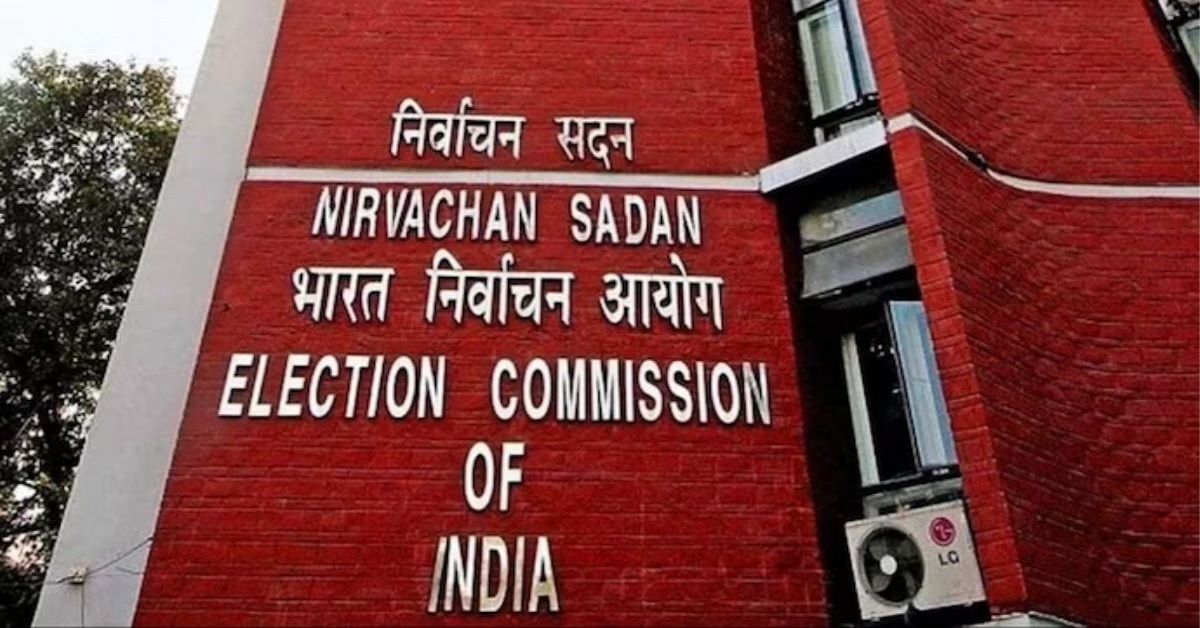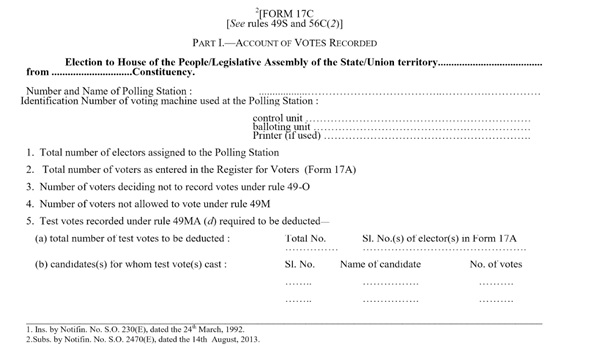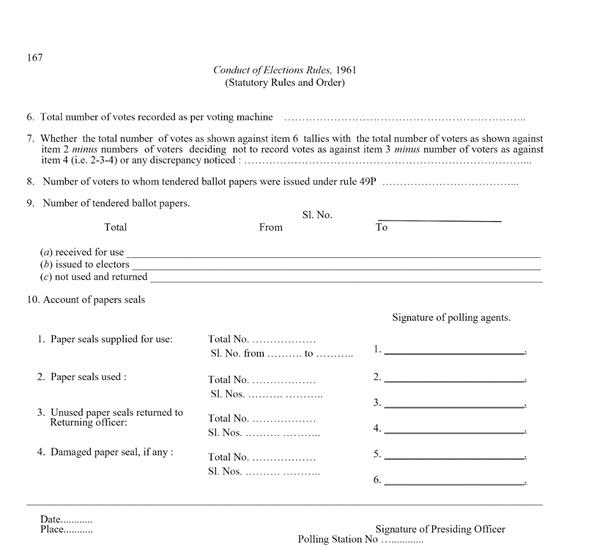In the plea filed by ADR to seek public disclosure of the copies of Form 17C within 48 hours of the conclusion of polling, the ECI has made questionable claims in its counter affidavit contesting the “legal right” to disclose Form 17C. On May 22, the Election Commission of India (ECI) filed this affidavit also attacking the intention of the petitioners, ADR.
In the ongoing case that will be heard tomorrow, Friday, May 24, (Association for Democratic Reforms v. Union of India [WP(C) 1382 of 2019]), while opposing the plea seeking public disclosure of the copies of Form 17C within 48 hours of the conclusion of polling. It is to be noted that Form 17 C contains the statutory record of votes polled in a polling station, the ECI has deliberately ignored Rule 93 of the Conduct of Elections Rules, 1961 that allow people to inspect and access copies of Form 17C.
Through this 66-page affidavit, the Constitutional authority has provided to the Supreme Court that there exists no legal mandate requiring the commission to disclose the final authenticated data of voter turnout in all polling stations and the same cannot be claimed as a legal right by anyone.
“It is submitted that there is no legal mandate to provide the Form 17C to any person other than the candidate or his agent.” (Para 20)
The aforementioned affidavit was filed by the ECI in the Interlocutory Application moved by Association for Democratic Reforms (ADR) and Common Cause on May 17 in their 2019 Public Interest Litigation (PIL). The said 2019 PIL had also sought for investigation into alleged discrepancies on voter turnout data during the 2019 General elections. Through the said plea, the petitioners had sought for the court’s direction ECI to upload “scanned legible copies of Form 17C Part-I (Account of Votes Recorded)” of all polling stations immediately after the polls.
An urgent hearing had been granted by the Supreme Court on the same day itself. During the hearing, a bench led by Chief Justice of India (CJI) D Y Chandrachud, also comprising Justices J B Pardiwala and Manoj Misra, had asked the ECI to provide an answer as to why Form 17 C is not being uploaded and the reservation regarding the said disclosure. Notably, the counsel of the ECI had stated in the court that that “there is no difficulty in making the data of Form 17 C available, it just took time”.
The bench had then asked the ECI to file a response to the above-mentioned IA. The hearing of the said matter will take place tomorrow i.e., on May 24.
Highlights from the affidavit filed by the ECI:
Election process already going: In its affidavit, ECI begins opposing the petitioners’ plea by stating that out of a total of 7 election phases, 5 have already completed (as on May 20). The last two phases of polling are scheduled for May 25 and June 1, with the counting to take place on June 4.
On delays and discrepancy in data: The affidavit stated that the voter turnout data is released, on a voluntary basis, through the Voter Turnout App at 2-hour intervals on polling day. It has been claimed by the Commission that the non-statutory disclosure through the app comes with a disclaimer and is reflective of the data capture taking place through various non-statutory sources.
“The facilitative framework had to balance between the speed of the disclosure to the public vis-à-vis a pin point accuracy, and, therefore, in time escalated ladder on the polling day, the broad trends were given the speed priority with clear disclaimers with regard to their accuracy and with the fact that they are liable to change.” (Para 26)
The affidavit adds that the disclosure on the app regarding the voter turnout is updated on percentage terms. With this, the affidavit provides an explanation on how voting continues till late evening while press releases are done on a specified timely basis. Based on the aforementioned process, explained in detail in the affidavit, the Commission denied there being any delay or discrepancy.
“There is neither delay nor difference in percentages of voter turnout data, more than what is inbuilt into the process, scale and magnitude in play.”
Rules governing elections do not allow disclosure to public: According to the affidavit, the ECI classified the Voter Turnout Disclosure into two categories – statutory (where Form 17C is given to polling agents), and non-statutory (where data is disclosed through ECI app, website and press releases).
The ECI contends that as per the Conduct of Election Rules governing the voting process, Form 17C needs to be given only to the polling agent. It is the ECI’s case that the said Rules do not permit the giving of Form 17C to any other entity. General disclosure of Form 17C to public is not contemplated by the rules, and any attempt to demand to will create a situation where any person can demand the Form.
“The legal regime with regard to Form 17C is peculiar that while it authorizes the polling agent at the close of the poll to get a copy of Form 17C, a general disclosure of the nature as sought by the Petitioner is not provided in the statutory framework. The Rules do not permit giving of the copy of Form 17C to any other entity. The contention of the petitioner creates a situation where any member of the public or the elector at the Polling Station can demand a copy of Form 17C on the argument that it partakes into a character of a public document.” (Para 32)
It is also the poll agency’s case that under Article 329(b) of the Constitution, judicial interference in electoral process from the date of notification till declaration of results is barred.
“The purpose of Article 329(b) is to ensure that the election process remains consistent and is not interfered with while it is ongoing”. (Para 72)
Possibility of misuse of data: Opposing the uploading of the requested data on the voter turn, the ECI alleged that the indiscriminate disclosure of Form 17C data would increase the possibility of images being morphed, including counting results, which can create widespread public discomfort and mistrust in the electoral process.
“It is submitted that a wholesome disclosure of Form 17C is amenable to mischief and vitiation of entire electoral space. At the moment, the original Form 17C is only available in the Strong Room and a copy only with the polling agents whose signature it bears. Therefore, there is a one-to one relationship between each Form 17C and its possessor. It is submitted that indiscriminate disclosure, public posting on the website increases the possibility of the images being morphed, including the counting results which then can create widespread public discomfort and mistrust in the entire electoral processes.” (Para 36)
Legal remedies in variance of data: Referring to the point of legal remedies against variance in data, the ECI points out that candidates as well as voters can file an election petition under the Representation of the People Act if they have a cause of action relating to any variance in statutory forms. However, the same remedies cannot be demanded for on the basis of the turnout uploaded on the app.
“However, no such consequence flows from a mismatch of information furnished in a voluntary non-statutory disclosure method such as that published in the Voter Turnout App“. (Para 40)
The issue of scanning: The affidavit also seeks to highlight certain logistical restrains that the Court needed to consider while hearing the said plea, which includes the most critical aspect of the location from which Form 17C should be scanned and uploaded.
“There are no scanners at the polling stations…If it is to be done centrally after aggregation by ARO or RO at Sub-Divisional or District head quarter, it violates the extant legal design of straight away keeping Form 17C in strong room after giving a copy to the agent of the candidate…there may be instances where the polling staff may not be so accustomed with technological aspects”. (Para 72)
According to the ECI, such logistical aspects will require advance planning and scheduling of training. The affidavit also mentions that if Form 17C data is made available on website, polling agents may not remain at polling stations towards the close of poll to sign Form 17C.
“The absence of signature of any polling agent on Form 17C may itself become a ground to challenge the veracity of the Form 17C and create further doubt and suspicion”. (Para 74)
Maintainability and intention of the petitioners: In the affidavit, the respondent (ECI) began with questioning the intention of the petitioners in the case. The ECI attacked ADR for misusing the process of law and filling multiple cases in the midst of elections, specifically pointing to the case of ADR vs ECI and Anr (EVM-VVPAT judgment), where the Supreme Court had dismissed the plea for 100% cross verification of Electronic Voting Machines (EVMs) data with Voter Verifiable Paper Audit Trail (VVPAT) records. With this, the ECI had, on the outset, urged the court of reject the IA on the issue of maintainability.
“The practice of creating false narrative and creative suspicion in the minds of the voters becomes much more discernible by the simultaneous one-sided campaign undertaken on social media immediately after the court proceedings.” (Para iii)
The ECI also accused the petitioners of not approaching the Courts with clean hands using the said the forum of the Court with an agenda to perpetually keep creating doubt in the mind of voters based on conspiracy theory.
“There is a consistent malafide campaign/design/efforts to keep on raising suspicion and doubt in every possible manner and by misleading assertions and baseless allegations regarding the conduct of elections by the Election Commission of India … the design and pattern in play is to spread doubts and damage is done by the time the truth … comes out.” (Para iv)
Furthermore, the ECI claimed that the plea is not maintainable in view of the principle of res judicata, as the Court has already considered various aspects in relation to Section 49S and Form 17C in the EVM-VVPAT judgment, which “fully applies to the present writ petition“.
The Commission also stated that disclosure of voter turnout data based on Form 17C will cause confusion among voters as it will also include postal ballot counts, and such chaos will them will be misused by those with motivated interests to case aspersion on the electoral process.
“In any electoral contest, the margin of victory may be very close. In such cases, disclosure of Form 17C in public domain may cause confusion in the minds of the voters with regard to the total votes polled as the latter figure would include the number of votes polled as per Form 17C as well as the votes received through postal ballots. However, such difference may not be easily understood by the voters and may be used by persons with motivated interests to cast aspersion on the whole electoral process … cause chaos in the election machinery which is already in motion.” (Para 68)
The complete affidavit can be read here:
Details of the IA filed by ADR:
The said Interlocutory Application had been moved before the Supreme Court on May 10. In their plea, the petitioners have stated that in the ongoing Lok Sabha elections, the ECI published voter turnout data after several days. As per the details provided, the data regarding the first phase of polling held on April 19 was published after eleven days while the second phase of polling held on April 26 was published after four days. in addition to this, the petition highlights that there was a variation of over 5% in the final voter turnout data from the initial data released on the polling day.
The plea has pointed to the “inordinate” delay in the release of final voter turnout data. The same is coupled with the unusually high revision of over 5 per cent in the voter turnout, specified in the poll panel’s press note of April 30, 2024, which has raised concerns and public suspicion regarding the correctness of the said data. As specified in the plea, the non-release of the absolute number of votes polled coupled with the “unreasonable delay” in the release of votes polled data has led to apprehensions in the mind of the electorate about the sharp increase between initial data and data released on April 30. Thus, citing upholding of the democratic process of election as well as ensuring that electoral irregularities do not subvert the same, the present IA was moved before the Court.
Further details on the plea can be read here.
What does the law actually say on Form 17C?
Form 17C is a crucial document that contains the account of the votes polled at a particular booth.
Some of the important details recorded in Form 17C:
- Total number of votes recorded as per voting machine at the Polling Station
- Total number of electors assigned to the Polling Station
- Total number of voters as entered in the Register for Voters (Form 17A)
- Number of voters not allowed to vote under rule 49M
- Any discrepancy observed between different entries and their total
One of the most essential uses of Form 17C is that the same can used as a basis of a legal dispute related to the poll result. It is essential to note that a total of three copies of Form 17 C are prepared- one of which is given to the Candidate, the second one stays with the ECI and the third is kept within the EVM box.
Rules and Guidelines regarding disclosure of Form 17C:
- Section 49S. (2) of the Conduct of Elections Rules, 1961 states “The presiding officer shall furnish to every polling agent present at the close of the poll a true copy of the entries made in Form 17C after obtaining a receipt from the said polling agent therefor and shall attest it as a true copy.” This clearly means that the data is already public.
Under the said Rule 49S and 56C, every Presiding Officer is also required to furnish to every polling agent present at the close of the poll, a true attested copy of the account of votes recorded as prepared by him/her in Form 17C, after obtaining a receipt from those polling agents. As such, the Presiding Officer should be asked to prepare such number of additional copies as the number of polling agents present in the polling station. Copies of the accounts should be furnished to every polling agent present even without the candidates asking for it. (Source: Handbook for Returning Officer 2023 – Para 13.49.1.)
- In order to ensure that abovementioned requirements of Rule 49S regarding furnishing of copies of account of votes recorded by polling agents are fulfilled by the Presiding Officer, the Commission has devised a declaration (Annexure 51 Part-Il), which should be made by the Presiding Officer at the close of poll. (Source: Handbook for Returning Officer 2023 – Para 13.50.1.)
- After the poll has been closed and the account of votes recorded in the voting machine has been prepared in Form 17C and copies thereof furnished to the polling agents present, EVM and VVPAT should be sealed and secured for transportation to the counting/collection centre. (Source: Handbook for Returning Officer 2023 – Para 13.51.1.)
- Ensure that copies of Form 17C for parliamentary election are supplied to polling agents of the candidates in parliamentary constituency only and copies of Form 17C for the assembly election are given only to the agents of candidates of assembly constituency. (Source: Handbook for Returning Officer 2023 – Para 14.13.1 (xvii))
- Question 16 in Annexure 28 in the ECI Handbook requires Micro Observer to answer “Yes” or “No” to the question “Whether copies of accounts of votes recorded in Form 17C have been given to the polling agents?” (Source: Handbook for Returning Officer 2023)
In addition to this, Rule 93 of Conduct of Elections Rules specifies the provisions related to the production and inspection of election papers. As per Clause 2 of the said Rule, subject to such conditions and to the payment of such fee as the Election Commission may direct, all other papers relating to the election shall be open to public inspection. This section essentially states that Form 17C can be made open for public inspection in accordance to the conditions and fee imposed by the ECI.
Related:
Glaring Mismatches in EVM Numbers Aggravate Concerns on ECI’s Poll Management
How safe is my vote? A detailed look back at the EVM-VVPAT controversy in India
Is the Indian EVM & VVPAT System free, fair, fit for elections or can it be manipulated?



